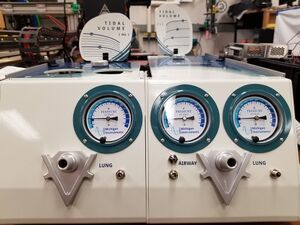
Introduction[edit | edit source]
Mechanical ventilators are essential medical devices that are used to assist patients with breathing [1]. However, they can also be very dangerous if they are not designed, and tested appropriately. One main way professionals test these ventilators is by using a device called a Testing and Train Lung, or TTL. For the purpose of this methods page, the exact TTL being used is the Michigan Instruments PneuView3, single adult and child lung. The TTL is used to simulate realistic lung responses to different ventilation methods and phenomena [2]. With this device, a ventilator can be properly tested and given to hospitals with no doubts in the manufacturers minds.
Open source ventilator designers wishing to have their prototypes tested should contact pearce@mtu.edu.
Safety[edit | edit source]
As according to the Michigan Instruments TTL manual [2]:
- Operate all TTL units within their specified limits. Over-inflation of the bellows or excessive pressure within the system may cause damage to the bellows and gauges.
- Do not sterilize the TTL. Some internal components are not compatible with sterilization techniques.
- Do not adjust the compliance setting during use. Changing the compliance setting while ventilating the lung may cause damage to the unit.
- Do not use a DC Power Supply with power ratings other than what is provided with the unit. Replacement power supplies are available from the manufacturer.
- Connect the DC Power Supply directly to a standard mains power jack. Use an appropriate and properly approved adaptor or connecting cord from the power supply to the
mains. Do not bypass or use any unapproved adaptor to connect to the mains.
- Do not plug in an O2 Sensor into the O2 Sensor port with power ratings other than what is provided with the unit. Replacement O2 Sensor s are available from the
manufacturer.
- DO not use the rail(s) on the lower side(s) of the lung when lifting or carrying the lung. Their alignment to the top plate is critical to maintaining the proper calibration of the lung.
Equipment or Bill of Materials[edit | edit source]
- Michigan Instruments Training and Test Lung
- Appropriate tubing
- Appropriate wiring
Calibration & Tolerances[edit | edit source]
All of this information can be found in the TTL manual [2].
Calibration[edit | edit source]
- Acquire a calibrated 1 L syringe, an independent, calibrated pressure gauge, and a small flat-head screwdriver.
For adult lung:
- Assemble the airway for ventilation of the lung using dual outlet pressure pickoff adaptor.
- Attach the second port of the pickoff adaptor to the independent pressure gauge.
- Keep the airway open to the air.
- Ensure that the lung, airway, and independent gauges are reading zero. If the gauges on the TTL are not zero, remove the plug in the gauge crystal and turn the adjusting screw until the needle is set to zero.
- Using the syringe, make 1.0 L injections at the compliance settings shown below.
| Compliance | Pressure Limits |
|---|---|
| 0.10 | 9.7 to 10.3 |
| 0.05 | 19.4 to 20.6 |
| 0.01 | 97.0 to 103.0 |
For infant lung:
- Follow steps 1-5 above.
- Using the syringe, make injections of 100 mL at the compliance settings shown below.
| Compliance | Pressure Limits |
|---|---|
| 0.010 | 9.7 to 10.3 |
| 0.005 | 19.4 to 20.6 |
| 0.001 | 97.0 to 103.0 |
If the TTL is not properly calibrated, contact Michigan Instruments’ Service Department at (800) 530-9939 x343. If the injection volumes are not 1.0 L(adult)/100 mL(infant), the TTL make experience a differing compliance than what is set.
TTL Leak Test[edit | edit source]
- Assemble the airway for ventilation.
- Confirm that all connections are secure.
- Set the compliance spring to 0.02(adult)/0.002(infant).
- Inject 1.0 L(adult)/100 mL(infant) of air into the lung through the airway.
- Note the lung and airway pressure.
- Hold the volume in the lung for 30 seconds and read the pressure gauges. The value should NOT have dropped more than 1.0 cmH2O in 30 seconds.
If a leak exists that cannot be fixed by tightening the airway connections, contact Michigan Instruments’ Service Department at (800) 530-9939 x343
Lung Compliance[edit | edit source]
- Loosen knob on compliance spring (shown below).
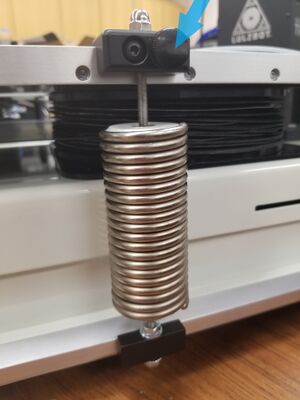
- While holding the spring, slide the mechanism until the pointer is on the desired compliance.
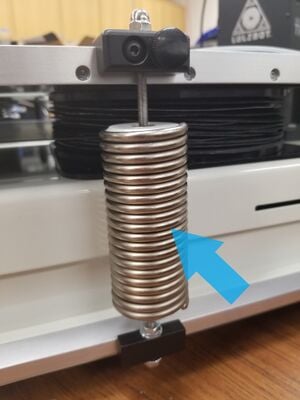
*For a healthy lung simulation, set the compliance to 0.2 L/cmH2O [3]. *For other circumstances, compliance can be calculated by the change in lung volume (L) over the change in pressure (cmH2O) [3]. *For patients on ventilation, compliance can be calculated by dividing the delivered tidal volume (L) by the (plateau pressure minus the total PEEP value) [3].
- Confirm that the spring is perpendicular to the lung plate.
- Tighten the knob to lock the spring in place.
Operation & Procedure[edit | edit source]
These procedures can be found in the TTL manual [2] on pages 11-13.
Set-Up[edit | edit source]
- Place machine on a level surface.
- Raise tidal volume scale plates until they are locked in position.
- Construct the airway using the accessories (i.e. adapters and tubing) that were given with the TTL.
For Single Adult/Infant Lung:
- Select a PneuFlo resistor (shown below) to stimulate airway resistance, and connect to the 15 mm airway adaptor.
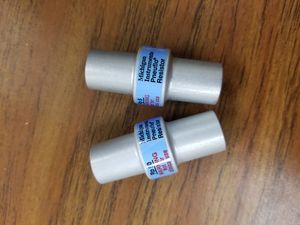
- Connect the other end of the adaptor to the "lung" port on the front of the TTL.
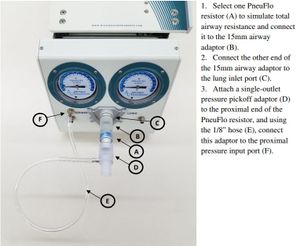
- Connect a single-outlet pressure pickoff adaptor to the proximal portion of the resistor. Use the 1/8" hose to connect the adaptor to the proximal pressure input port.
Ventilator Testing[edit | edit source]
- Attach the patient connection of the ventilator's breathing circuit to the airway of the TTL.
- Set the ventilator to the appropriate settings according to the testing protocol:
*Normal/healthy adult single lung: compliance=0.05 L/cmH2O; Resistance=Rp5
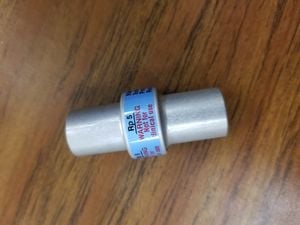
*Normal/healthy infant single lung: compliance=0.005 L/cmH20; Resistance=Rp50
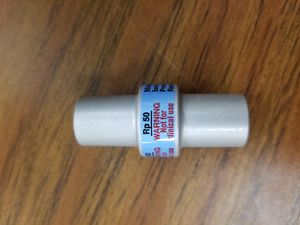
*For testing protocol, refer to https://www.appropedia.org/Open_source_ventilator
- Record the pressure, tidal volume, FIO2, timing and flow measurements.
- Repeat steps 1-4 for n-tests (n=the number of tests desired) and record the results.
Oxygen Concentration[edit | edit source]
To measure O2 concentration:
- Remove the oxygen port cover (shown below).
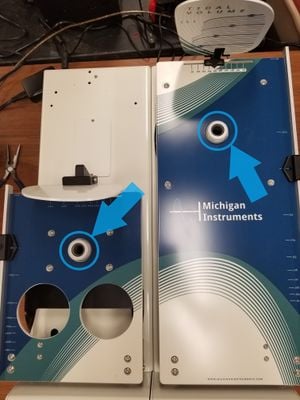
- Place an O2 sensor into the port.
- Connect the O2 sensor to the O2 jack on the back plate (shown below).
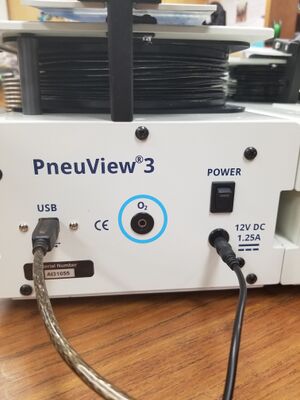
Pulmonary Simulation[edit | edit source]
- Set lung compliance to 0.05(adult)/0.005(infant) L/cmH2O.
- Set total airway resistance to Rp5(adult)/Rp50(infant).
- Ventilate the TTL at a rate of 12 bpm with a tidal volume of ~0.80 L(adult)/80 mL(infant).
- Note the tidal volume being delivered to the lung.
- Note the pressure generated in the lung and airway.
- Change the compliance of the lung to 0.03(adult)/0.003(infant), then 0.02(adult)/0.002(infant), and finally 0.01(adult)/0.001(infant).
- Note the differing lung volume and pressure.
Shutdown[edit | edit source]
All of this information can be found in the TTL manual [2].
Caring for the TTL after Ventilation[edit | edit source]
- Sterile water and normal saline solution will NOT harm the TTL.
- Extra moisture should be drained after each usage.
- Accumulated fluid can be drained through the O2 sensor port (shown below) by turning over the TTL with the port caps removed. Replace the caps and ventilate the TTL with dry gas until there is no condensation remaining.

To turn off the device after use[edit | edit source]
- Turn the power button to off on the back of the TTL.
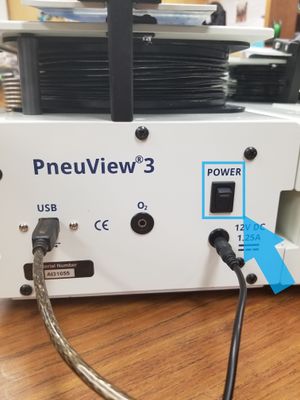
References[edit | edit source]
- Cleveland Clinic, "Mechanical Ventilation", 2019. https://my.clevelandclinic.org/health/articles/15368-mechanical-ventilation
- Michigan Instruments, "Training & Test Lung Operation Manual", 2017. https://www.michiganinstruments.com/wp-content/uploads/2018/11/TTL3OpsManualREV2017-05.pdf
- "Mechanics of Ventilation". http://www.ubccriticalcaremedicine.ca/rotating/material/Lecture_1%20for%20Residents.pdf

